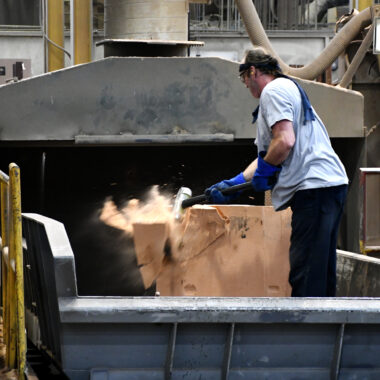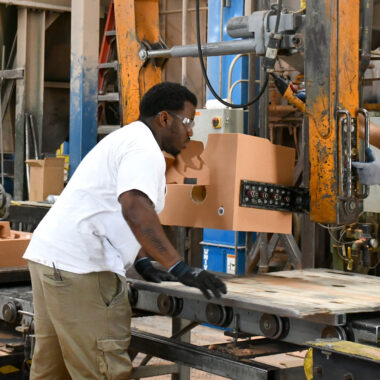Advancement in Light Weight Aluminum Casting: Cutting-Edge Techniques for Modern Developers
What genuinely sets these developments apart are the sustainable light weight aluminum alloys being created and the high-pressure die casting techniques that are revolutionizing the sector. Join us as we discover the leading edge of aluminum spreading advancement, where innovation meets creative thinking to redefine what is feasible in the world of steel spreading.

Advanced 3D Printing Techniques
Using sophisticated additive manufacturing processes, advanced 3D printing methods have actually revolutionized the production of complex and tailored light weight aluminum components. By employing high-precision printers that can work with light weight aluminum powders or filaments, suppliers can develop complex geometries and designs that were previously unattainable with standard production methods.
Among the key advantages of advanced 3D printing in aluminum component production is the ability to accomplish lightweight yet resilient structures. This is especially helpful in sectors such as aerospace and vehicle, where weight decrease is essential for boosting fuel performance and overall performance. In addition, the customization options provided by 3D printing enable for the production of distinct and tailored components that meet specific requirements, bring about boosted capability and efficiency.
Additionally, the performance of the 3D printing process reduces material waste and reduces the total production time, making it an affordable solution for making light weight aluminum elements. As technology proceeds to advance, the capacities of 3D printing in light weight aluminum production are anticipated to broaden, offering also higher possibilities for technology in different industries.
Computer-Aided Layout Advancements
With the developments in innovative 3D printing methods for aluminum elements, the integration of Computer-Aided Layout (CAD) software has actually become significantly critical in driving innovation and effectiveness in the manufacturing process. CAD innovations have changed the method developers and engineers develop aluminum casting mold and mildews by providing exact digital modeling abilities. These software program tools permit the creation of complex layouts and simulations that optimize the spreading procedure, resulting in higher top quality components.
One of the vital benefits of CAD in aluminum spreading is the capacity to spot prospective concerns early in the design phase, minimizing pricey errors and rework during manufacturing. By imitating the casting process essentially, developers can assess factors such as cooling rates, product circulation, and architectural honesty prior to a physical mold and mildew is created. This positive technique not just conserves time and sources yet additionally makes certain that the last light weight aluminum parts meet the wanted requirements.
Moreover, CAD software allows quick versions and adjustments to styles, assisting in quick prototyping and modification to fulfill details needs. By leveraging CAD technologies in light weight aluminum spreading, suppliers can simplify their procedures, boost item high quality, and stay at the leading edge of development in the industry.
High-Pressure Die Casting Methods
High-pressure die spreading approaches are commonly acknowledged for their effectiveness and precision in producing intricate light weight aluminum elements. By utilizing high pressure to compel liquified aluminum into detailed mold and mildews at fast speeds, this strategy enables for the development of dimensionally exact and in-depth parts. Among the crucial advantages of high-pressure die spreading is its capability to produce components with fine information and slim walls, making it excellent for applications where light-weight yet strong parts are needed.
The process starts with the preparation of the die, which is commonly made from solidified device steel and contains 2 halves that develop the wanted part form. The liquified aluminum is after that injected into the die dental caries under high pressure, making sure that the product fills all the detailed features of the Look At This mold. As soon as the aluminum solidifies, the die opens up, disclosing the finished component all set for any needed post-processing.
High-pressure die spreading is commonly utilized in numerous sectors, including vehicle, aerospace, and electronic devices, where high-volume production of complex aluminum elements is called for. casting aluminum illinois. Its ability to deliver tight resistances, superb surface area finishes, and affordable production makes it a favored selection for modern-day creators aiming to innovate in aluminum spreading strategies
Sustainable Aluminum Alloys Development

One strategy to sustainable light weight aluminum alloy navigate to these guys growth includes including recycled aluminum material right into the alloy composition. By making use of recycled aluminum, producers can lower energy usage and greenhouse gas exhausts related to main light weight aluminum production. Furthermore, reusing light weight aluminum helps divert waste from land fills, adding to a much more round economic situation.
Furthermore, researchers are discovering brand-new alloying elements and processing methods to boost the sustainability of light weight aluminum alloys. By optimizing alloy compositions and producing procedures, it is feasible to boost you can try here the recyclability, resilience, and general ecological efficiency of light weight aluminum items.

Automation and Robotics Assimilation
In the world of sustainable light weight aluminum alloys advancement, the integration of automation and robotics is changing producing processes, leading the method for increased performance and precision in manufacturing. Automation and robotics are improving traditional spreading techniques, supplying various benefits to designers in the aluminum market. By incorporating automation right into the casting procedure, repetitive tasks that were as soon as labor-intensive can now be successfully dealt with by robot systems, decreasing the threat of human error and raising overall efficiency.
Automated systems can work around the clock, making certain a constant manufacturing cycle that minimizes downtime and maximizes outcome. Robotics assimilation allows for intricate mold and mildews and elaborate styles to be generated with exceptional precision, fulfilling the demands of contemporary designers for high-quality aluminum elements. The usage of automation in casting operations advertises a more secure working environment by reducing the exposure of workers to harmful problems.
Verdict
Advanced 3D printing techniques, computer-aided design technologies, high-pressure die spreading techniques, sustainable light weight aluminum alloys growth, and automation and robotics combination have all contributed to the innovation of the spreading process. The future of light weight aluminum spreading is brilliant with continuous technology and technical developments.
What truly establishes these advancements apart are the sustainable light weight aluminum alloys being established and the high-pressure die casting strategies that are transforming the industry. Join us as we discover the leading edge of light weight aluminum casting innovation, where modern technology satisfies creativity to redefine what is feasible in the world of steel casting.
One strategy to sustainable light weight aluminum alloy advancement entails integrating recycled light weight aluminum material right into the alloy structure - casting aluminum illinois. By making use of recycled aluminum, suppliers can decrease power consumption and greenhouse gas exhausts associated with key aluminum production. Advanced 3D printing strategies, computer-aided design technologies, high-pressure die casting techniques, lasting aluminum alloys advancement, and automation and robotics integration have all contributed to the innovation of the spreading process
Comments on “Revealing Excellence: Understanding Casting Aluminum Illinois”